Experimental Investigation of the Effect of Solvent Type and Its Concentration on the Performance of ES-SAGD
Abstract
1. Introduction
2. Motivation
3. Experimental Design
3.1. Core Flooding Setup Description
3.2. Materials
3.2.1. Sand Pack Properties
3.2.2. Fluid Properties
3.3. Experimental Procedure
- The clean and dry sand pack is first weighed using an accurate balance, then flushed with carbon dioxide gas for 20 min to displace the trapped air. Afterward, it is evacuated to remove the carbon dioxide gas from the system. Once the evacuation is complete, the sand pack is saturated with deionized water. At the end of this stage, the weight of the sand pack is measured again. The difference between the weight of the dry sand pack and the wet sand pack represents the weight of the imbibed water in the sand pack.
- The sand pack is placed in an oven at 75 °C for a couple of hours to preheat the system before oil flooding. Similarly, the oil transfer vessel is heated to the same temperature to mobilize the bitumen. The bitumen is then injected into the sand pack at 75 °C with a flow rate of 1 cm3/min until oil breakthrough occurs. Oil flooding is terminated after the breakthrough, and the mass of produced water is measured to determine the irreducible water saturation remaining in the system at the end of this stage.
- Before starting steam (or steam/solvent) injection, the power to the heating tape installed between the injection and production ports on the sand pack is switched on. The system is heated until the temperature in zone (I) reaches 80 °C. This preheating stage is kept the same for all tests. Meanwhile, steam or steam/solvent injection begins in the steam generator, with the set temperature maintained at 235 °C using a temperature controller. This temperature is consistent across all tests. However, the fluid initially flows through the bypass line and is produced from the BPR without contacting the sand pack. This step continues for over an hour to ensure that both the production and injection lines are sufficiently heated before bitumen production begins.
- Once the system is sufficiently heated and the temperature of thermocouple #1 reaches 80 °C, steam or steam/solvent is injected into the sand pack at a constant total flow rate of 2.0 cm3/min using a constant flow pump. The outlet pressure is set on the BPR and installed at the outlet to a fixed pressure lower than the steam pressure. This set pressure is kept the same across all core flooding tests. At this point, no additional heat is introduced into the system from the heating tape. The injection continues for over six hours, during which several samples of the produced effluent are collected from the sand pack. The temperature in different zones of the sand pack is recorded and monitored for later analysis. The outlet pressure remains constant throughout the experiment.
- Keeping the steam generator as close to the sand holder as possible and shortening the tubing. The steam generator was kept inside a box that was fully isolated, and the tubing coming from the steam generator was also wrapped with isolation material and a heating tape to maintain the temperature.
- Installing two thermocouples, one at the outlet of the steam generator and another one at the injection port of the sand pack, to monitor the temperature of steam coming from the steam generator and before injecting into the sand pack.
- Preheating the bottom part of the sand pack up to 80 °C prior to the test to generate the connection between injector and producer and mobilizing the bitumen.
- Pre-circulating the steam to stabilize the steam temperature in the injector and steam generator before running the test.
- Wrapping the whole sand pack body with a thick layer of isolation material to reduce the heat loss from the metal body of the sand pack.
3.4. Effluent Sample Analysis
4. Results and Discussion
4.1. Temperature Profile Within the Sand Pack
4.2. Cumulative Oil Production and Oil Recovery
4.3. Steam-to-Oil Ratio and Oil Production Rate
4.4. Final Water Cut
4.5. Interfacial Tension, Solubility, and Viscosity of Solvent Additive Bitumen
4.6. Limitations
- One of the main limitations of the laboratory-scale core flooding tests is the significant heat loss, especially in small sand pack models. This is due to the substantial temperature differences between the ambient environment and the SAGD chamber. Furthermore, since the amount of heat injected into the system is relatively small, even minor heat loss through the piping can lead to a phase change in the system, potentially impacting the efficiency of the process. To mitigate this, working with a larger model, such as a 3D physical model, could increase the volume-to-surface ratio, thus reducing heat loss and more accurately representing field-scale conditions.
- Solvent recovery is a critical parameter in any solvent-additive SAGD project due to the high cost of solvents compared to crude oil. Although solvent recovery was not within the scope of this study, it represents a limitation of the current research. To address this issue, future experiments should collect produced samples in a pressure vessel. After cooling the system, the pressure must be gradually released, as both butane and propane can escape from the effluent. Therefore, incorporating a separator and pressure vessel in the experimental setup is necessary for accurate solvent recovery assessment. Since the effluent samples in this study were collected at ambient conditions, solvent recovery could not be properly evaluated.
5. Summary and Conclusions
- The temperature of the steam chamber was highest in the base-SAGD experiment, where the temperature in all three zones reached that of the injected steam. In the ES-SAGD experiments, co-injecting propane reduced the chamber temperature to around 48 °C, while butane raised the temperature by 21 °C compared to propane. This difference was attributed to the partial pressure of steam in the gaseous phase, affecting condensation rates.
- Introducing light hydrocarbon solvents improved SAGD performance significantly, with oil recovery increasing by 19% to 36%. Butane was more effective than propane in enhancing oil recovery, likely due to its higher boiling point, better solubility in oil, higher thermal conductivity, and more effective viscosity reduction properties.
- The steam-to-oil ratio (SOR) was notably high in all experiments, reaching 20 g/g. This value was higher than typical field SORs due to substantial heat loss from the sand pack holder and limited space for lateral expansion of the steam chamber. The SOR was 40% lower in the ES-SAGD experiment using an 80% butane/20% propane mixture, demonstrating the benefits of solvent addition in improving SAGD performance.
- The optimal composition of the butane/propane mixture for maximum oil recovery was 80% butane and 20% propane. However, pure butane achieved the highest rate of oil production. Oil recovery exceeded 99% with the 80%C4–20%C3 mixture after injecting 9.5 PV of steam. However, more investigations need to be conducted in the future research to find the optimum concentration. It is notable that, by considering the molecular interaction between bitumen and solvents in molecular scale, the results may differ from the observation here.
- The water cut in the produced effluents was high across all experiments, consistent with the SAGD well configuration. The base-SAGD experiment had the highest water cut, while the lowest was observed at the start of the experiment with 100% butane. The water cut was lowest in the 80%C4–20%C3 mixture experiment in the later stages of production.
Author Contributions
Funding
Institutional Review Board Statement
Informed Consent Statement
Data Availability Statement
Acknowledgments
Conflicts of Interest
Nomenclature
| Water pressure | |
| Irreducible water saturation | |
| Residual oil saturation | |
| Temperature | |
| Greek symbols | |
| Water viscosity | |
| Bitumen density | |
| Bitumen viscosity | |
| Water density | |
| BPR | Back pressure regulator |
| Cum | Cumulative |
| GHG | Green house gases |
| HT | High temperature |
| TEOR | Thermal enhanced oil recovery |
| SOR | Steam-to-oil tatio |
| VAPEX | Vapor extraction |
| CSS | Cyclic steam stimulation |
| ES-SAGD | Expanded Solvent-SAGD |
| HP | High pressure |
| PV | Pore volume |
| SAGD | Steam-assisted gravity drainage |
| Vol.% | Volume percent |
References
- Esmaeili, S.; Sarma, H.; Harding, T.; Maini, B. A data-driven model for predicting the effect of temperature on oil-water relative permeability. Fuel 2019, 236, 264–277. [Google Scholar]
- Butler, R.M. Method for Continuously Producing Viscous Hydrocarbons by Gravity Drainage While Injecting Heated Fluids. CA 331,464, 24 August 1982. [Google Scholar]
- Butler, R.M. Thermal Recovery of Oil and Bitumen; Prentice Hall Publishing Company: Hoboken, NJ, USA, 1991. [Google Scholar]
- Yongbin, W.; Xiuluan, L.; Xinge, S.; Desheng, M.; Hongzhuang, W. Key parameters forecast model of injector wellbores during the dual-well SAGD process. Pet. Explor. Dev. 2012, 39, 514–521. [Google Scholar]
- Yongbin, W.U.; Xueqi, L.I.; Xuan, D.U.; Xiaoyi, Z.H.; Li, W.A.; Jun, L.I.; Yanhong, L.I.; Xiuluan, L.I.; Yang, L.I. Scaled physical experiments on drainage mechanisms of solvent-expanded SAGD in super-heavy oil reservoirs. Pet. Explor. Dev. 2020, 47, 820–826. [Google Scholar]
- Yongrong, G.; Erpeng, G.; Dehuang, S.; Bojun, W. Air-SAGD technology for super-heavy oil reservoirs. Pet. Explor. Dev. 2019, 46, 113–120. [Google Scholar]
- You, Z.; Teng, L.; Shouya, W.; Lanxiang, S.; Xuan, D.; Junling, W. Models of steam-assisted gravity drainage (SAGD) steam chamber expanding velocity in double horizontal wells and its application. Pet. Explor. Dev. 2019, 46, 347–354. [Google Scholar]
- Nasr, T.N.; Isaacs, E.E. Process for Enhancing Hydrocarbon Mobility Using a Steam Additive. U.S. Patent 6,230,814, 15 May 2001. [Google Scholar]
- Gupta, S.; Gittins, S.; Picherack, P. Field implementation of solvent aided process. J. Can. Pet. Technol. 2005, 44. [Google Scholar] [CrossRef]
- Leaute, R.; Carey, B. Liquid addition to steam for enhancing recovery (LASER) of bitumen with CSS: Results from the first pilot cycle. J. Can. Pet. Technol. 2007, 46. [Google Scholar] [CrossRef]
- Ayodele, O.; Nasr, T.; Beaulieu, G.; Heck, G. Laboratory experimental testing and development of an efficient low pressure ES-SAGD process. J. Can. Pet. Technol. 2009, 48, 54–61. [Google Scholar]
- Faradonbeh, M.R.; Harding, T.; Abedi, J. Semi-analytical modeling of steam-solvent gravity drainage of heavy oil and bitumen: Steady state model with linear interface. Fuel 2016, 183, 568–582. [Google Scholar] [CrossRef]
- Gates, I.D. Solvent-aided steam-assisted gravity drainage in thin oil sand reservoirs. J. Pet. Sci. Eng. 2010, 74, 138–146. [Google Scholar]
- Venkat Venkatramani, A.; Okuno, R. Steam-Solvent Coinjection Under Reservoir Heterogeneity: Should ES-SAGD Be Implemented for Highly Heterogeneous Reservoirs? In SPE Canada Heavy Oil Technical Conference; Society of Petroleum Engineers: Richardson, TX, USA, 2017. [Google Scholar]
- Ardali, M.; Mamora, D.; Barrufet, M.A. Experimental study of co-injection of potential solvents with steam to enhance SAGD process. In Proceedings of the SPE Western North American Region Meeting, Anchorage, AK, USA, 7–11 May 2011; Society of Petroleum Engineers: Richardson, TX, USA, 2011. [Google Scholar]
- Nejatian Daraei, H.; Khodapanah, E.; Sahraei, E. Experimental investigation of steam-CO2-foam flooding: Combination of CO2-foam flooding and steam injection as an effective enhanced oil recovery (EOR) method in heavy oil reservoirs. Asia-Pac. J. Chem. Eng. 2015, 10, 377–386. [Google Scholar] [CrossRef]
- Yuan, Z.; Liu, P.; Zhang, S.; Li, X.; Shi, L.; Jin, R. Experimental study and numerical simulation of nitrogen-assisted SAGD in developing heavy oil reservoirs. J. Pet. Sci. Eng. 2018, 162, 325–332. [Google Scholar]
- Coelho, R.; Ovalles, C.; Benson, I.P.; Hascakir, B. Effect of clay presence and solvent dose on hybrid solvent-steam performance. J. Pet. Sci. Eng. 2017, 150, 203–207. [Google Scholar]
- Rivero, J.; Mamora, D. Production acceleration and injectivity enhancement using steam-propane injection for Hamaca extra-heavy oil. In Proceedings of the SPE/DOE Improved Oil Recovery Symposium, Tulsa, OK, USA, 16–18 April 2002; Society of Petroleum Engineers: Richardson, TX, USA, 2002. [Google Scholar]
- Souraki, Y.; Ashrafi, M.; Torsaeter, O. Experimental investigation and comparison of thermal processes: SAGD, ES-SAGD and SAS. Int. J. Eng. Trends Technol. 2016, 31. [Google Scholar] [CrossRef]
- Kar, T.; Stape, P.; Mukhametshina, A.; Hascakir, B. Effect of Solvent Type on Water-in-Oil Emulsion Formation for Steam Flooding and Steam Assisted Gravity Drainage. Can. Heavy Oil Assoc. (CHOA) J. 2016, 13–19. [Google Scholar]
- Li, W.; Mamora, D.; Li, Y. Light-and heavy-solvent impacts on solvent-aided-SAGD process: A low-pressure experimental study. J. Can. Pet. Technol. 2011, 50, 19–30. [Google Scholar]
- Li, W.; Mamora, D.D.; Li, Y. Solvent-type and-ratio impacts on solvent-aided SAGD process. SPE Reserv. Eval. Eng. 2011, 14, 320–331. [Google Scholar]
- Yazdani, A.J.; Alvestad, J.; Kjoensvik, D.; Gilje, E.; Kowalewski, E. A parametric simulation study for solvent co-injection process in bitumen deposits. In Proceedings of the Canadian Unconventional Resources Conference, Calgary, AB, Canada, 15–17 November 2011; Society of Petroleum Engineers: Richardson, TX, USA, 2011. [Google Scholar]
- Ardali, M.; Mamora, D.D.; Barrufet, M. A comparative simulation study of addition of solvents to steam in SAGD process. In Proceedings of the Canadian Unconventional Resources and International Petroleum Conference, Calgary, AB, Canada, 19–21 October 2010; Society of Petroleum Engineers: Richardson, TX, USA, 2010. [Google Scholar]
- Hascakir, B. How to select the right solvent for solvent-aided steam injection processes. J. Pet. Sci. Eng. 2016, 146, 746–751. [Google Scholar]
- Dong, L. Effect of vapour–liquid phase behaviour of steam–light hydrocarbon systems on steam assisted gravity drainage process for bitumen recovery. Fuel 2012, 95, 159–168. [Google Scholar]
- Eghbali, S.; Dehghanpour, H. A Simulation Study on Solvent-Aided Process using C3 and C4 in Clearwater Oil-Sand Formation. J. Pet. Sci. Eng. 2020, 184, 106267. [Google Scholar]
- Ul Abidin, Z. Evaluation of Propane-Butane Mixtures as Solvent in ES-SAGD. Master’s Thesis, University of Calgary, Calgary, AB, Canada, 2022. [Google Scholar]
- Esmaeili, S.; Sarma, H.; Harding, T.; Maini, B. Two-phase bitumen/water relative permeability at different temperatures and SAGD pressure: Experimental study. Fuel 2020, 276, 118014. [Google Scholar] [CrossRef]
- Esmaeili, S.; Sarma, H.; Harding, T.; Maini, B. Experimental study of the effect of solvent addition and temperature on two-phase bitumen/water relative permeability. SPE Reserv. Eval. Eng. 2020, 23, 1381–1402. [Google Scholar] [CrossRef]
- Esmaeili, S.; Sarma, H.; Harding, T.; Maini, B. The Effect of Temperature on Two-Phase Oil/Water Relative Permeability in Different Rock/Fluid Systems. In Proceedings of the SPE Annual Technical Conference and Exhibition, Calgary, AB, Canada, 30 September–2 October 2019; SPE-195859-MS. Society of Petroleum Engineers: Richardson, TX, USA, 2019. [Google Scholar]
- Esmaeili, S.; Sarma, H.; Harding, T.; Maini, B. Effect of Temperature on Bitumen/Water Relative Permeability in Oil Sands. Energy Fuels 2020, 34, 12314–12329. [Google Scholar] [CrossRef]
- Likhachev, E. Dependence of water viscosity on temperature and pressure. Tech. Phys. 2003, 48, 514–515. [Google Scholar] [CrossRef]
- Chakrabarty, N. Optimization of steam-assisted gravity drainage (SAGD) in ideal McMurray Reservoir. In Proceedings of the Canadian International Petroleum Conference, Calgary, AB, Canada, 7–9 June 2005. [Google Scholar]
- Haddadnia, A.; Sadeghi Yamchi, H.; Zirrahi, M.; Hassanzadeh, H.; Abedi, J. New solubility and viscosity measurements for methane–, ethane–, propane–, and butane–Athabasca bitumen systems at high temperatures up to 260 °C. J. Chem. Eng. Data 2018, 63, 3566–3571. [Google Scholar] [CrossRef]
- Kariznovi, M.; Nourozieh, H.; Abedi, J. Phase behavior and viscosity measurements of heavy crude oil with methane and ethane at high-temperature conditions. In Proceedings of the SPE Western Regional Meeting, Bakersfield, CA, USA, 21–23 March 2012; SPE: Richardson, TX, USA, 2012. [Google Scholar]
- Frauenfeld, T.; Gerald, K.; Zhou, S. PVT and Viscosity Measurements for Lloydminster-Aberfeldy and Cold Lake Blended Oil Systems. In Proceedings of the International Thermal Operations and Heavy Oil Symposium and International Horizontal Well Technology Conference, Calgary, AB, Canada, 4−7 November 2002; Society of Petroleum Engineers: Richardson, TX, USA, 2002. [Google Scholar]
- Han, B.; Yang, G.; Ke, J.; Mao, C.; Yan, H. Phase Equilibria of Supercritical Propane−Fengcheng Bitumen System and the Density and Viscosity of the Liquid Phase. Fluid Phase Equilibria 1998, 143, 205–211. [Google Scholar] [CrossRef]
- Nourozieh, H.; Kariznovi, M.; Abedi, J. Measurement and Modeling of Solubility and Saturated-Liquid Density and Viscosity for Methane/Athabasca-Bitumen Mixtures. SPE J. 2016, 21, 180–189. [Google Scholar] [CrossRef]
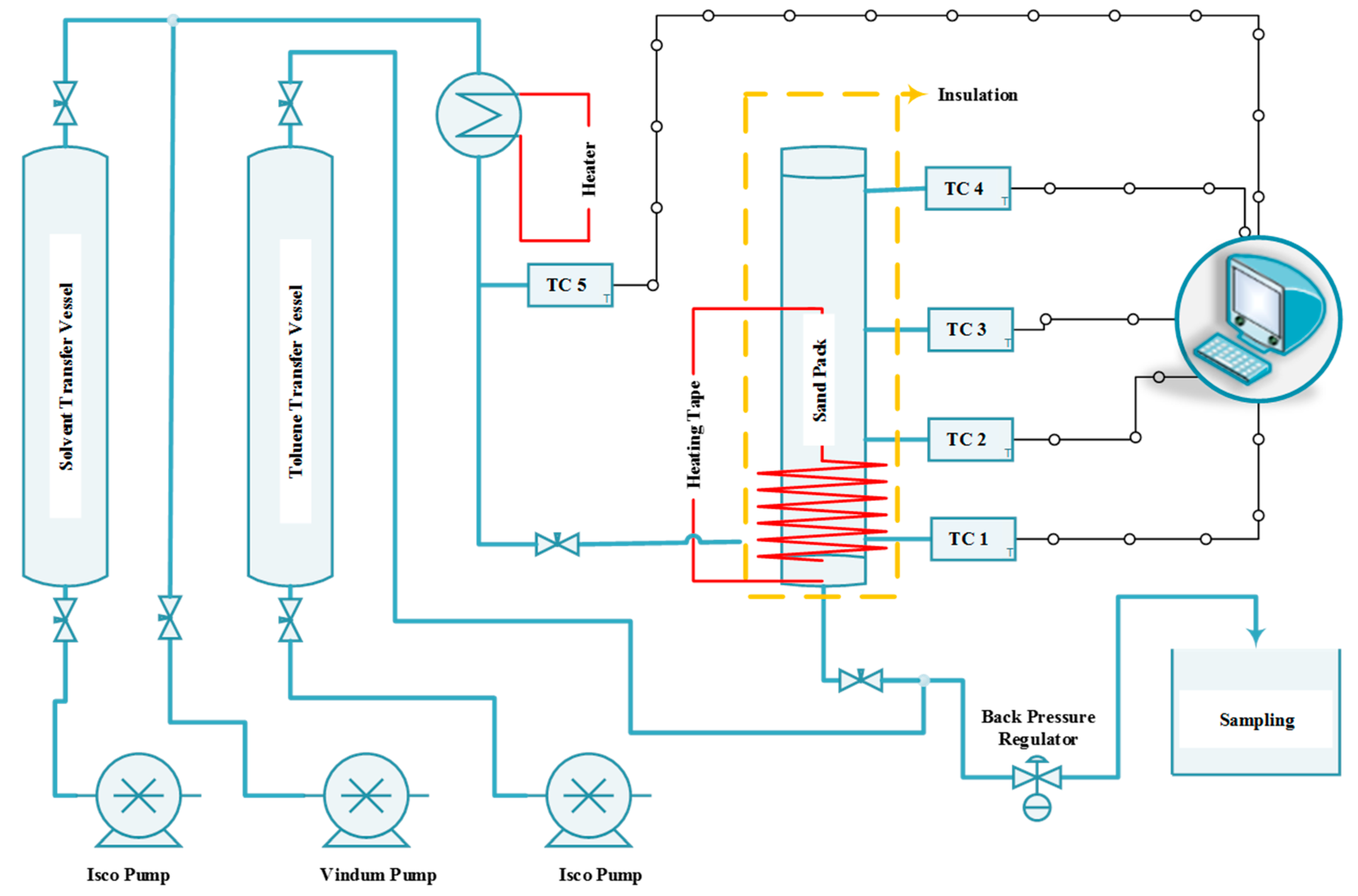

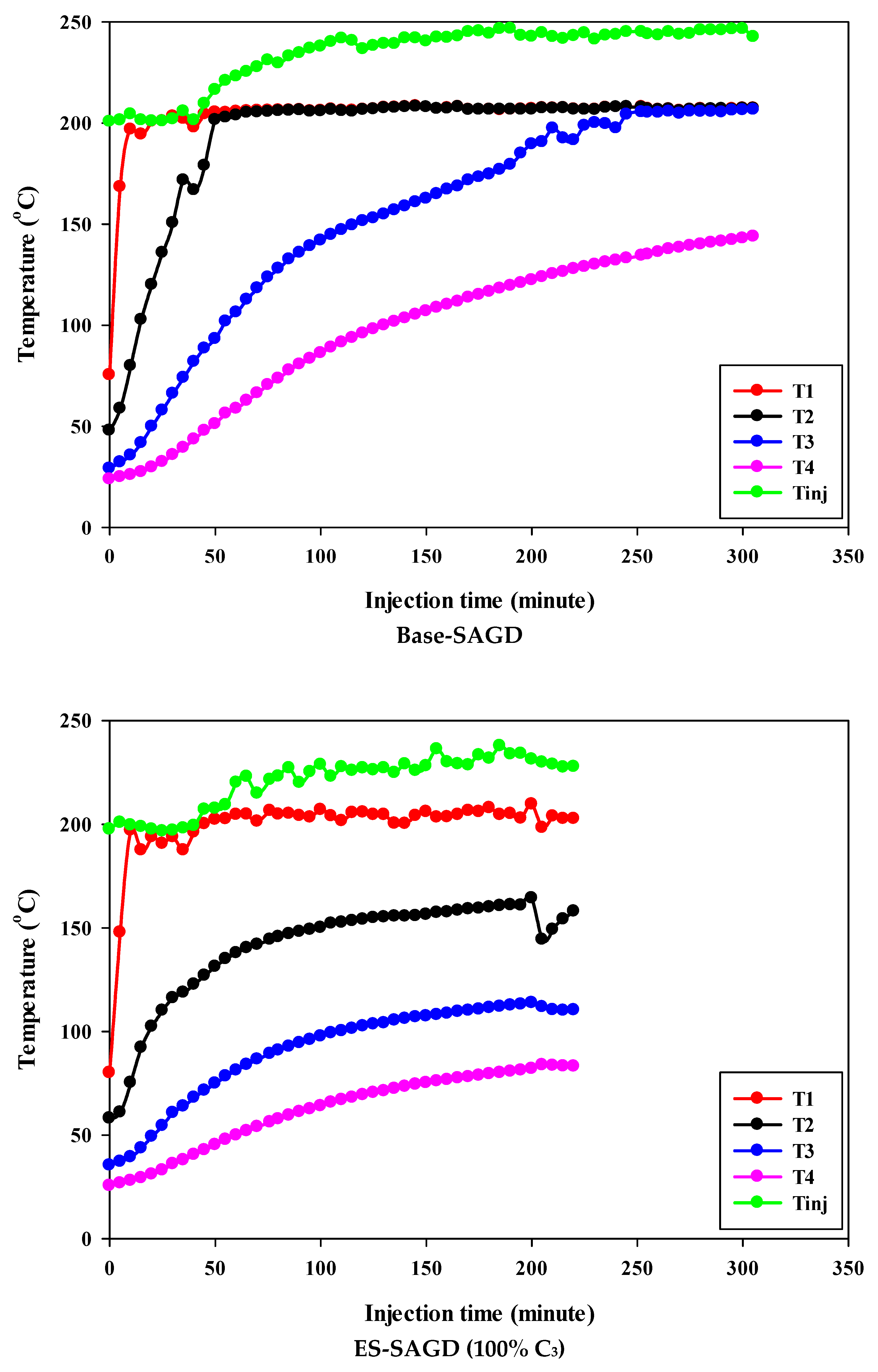

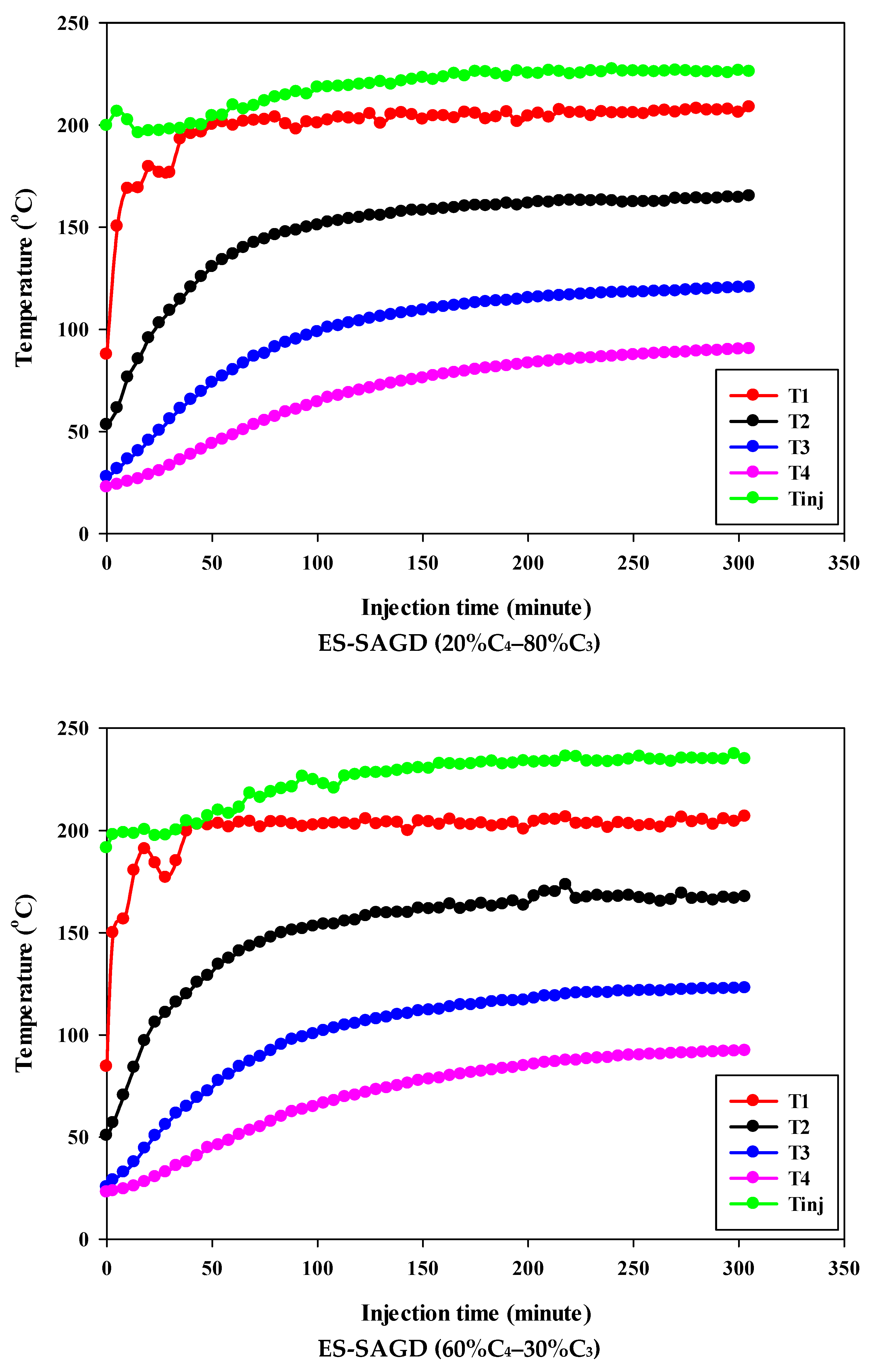

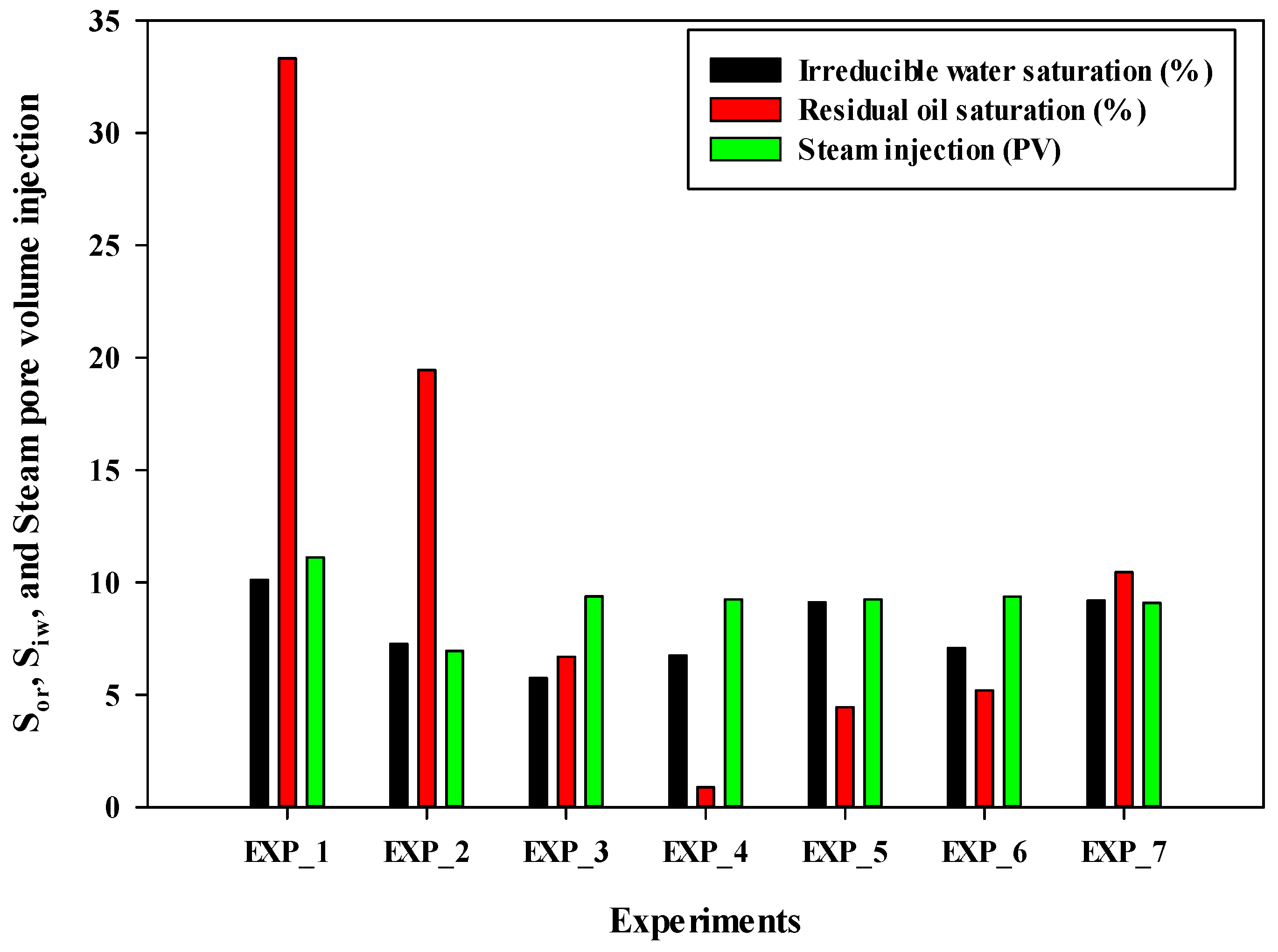
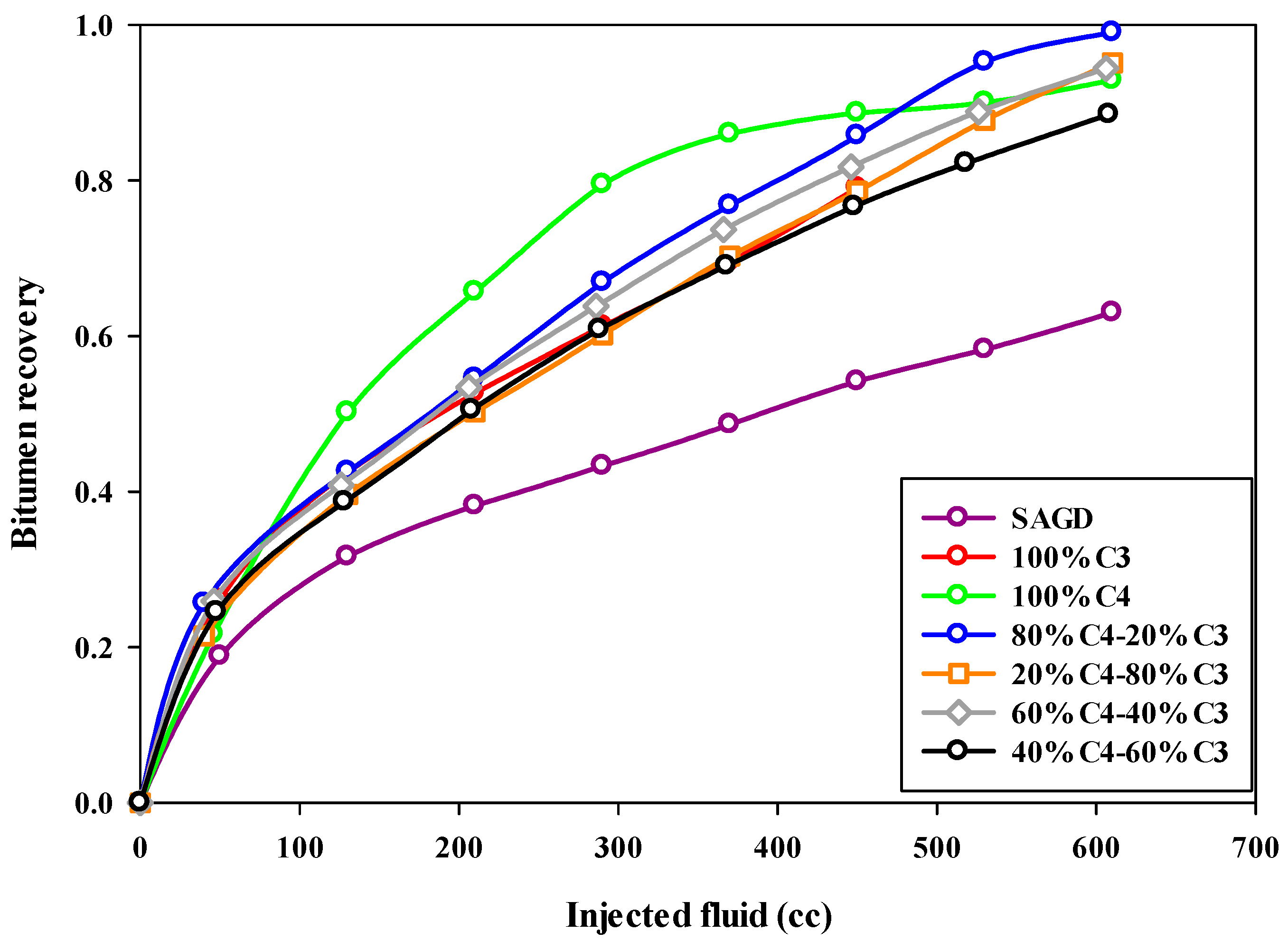
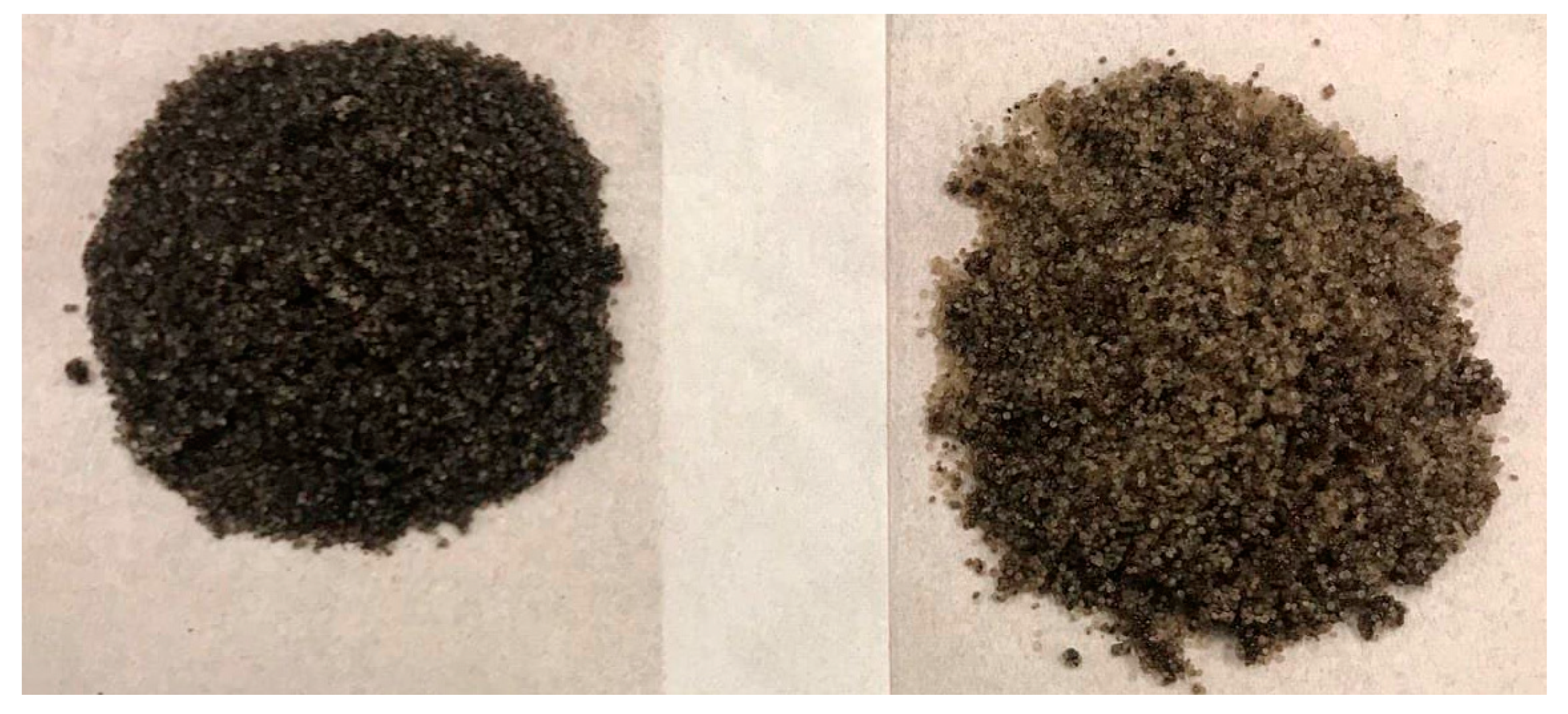
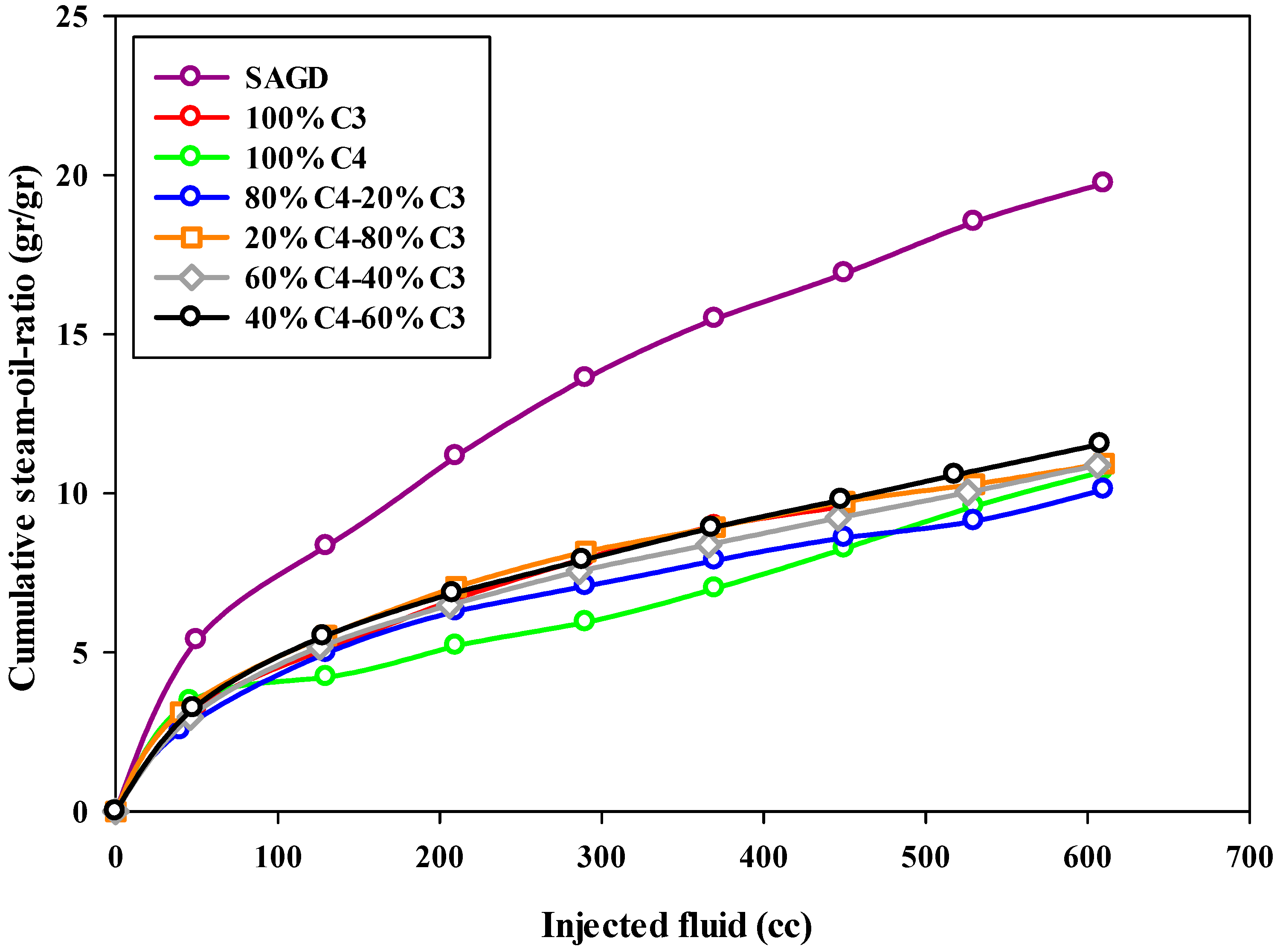

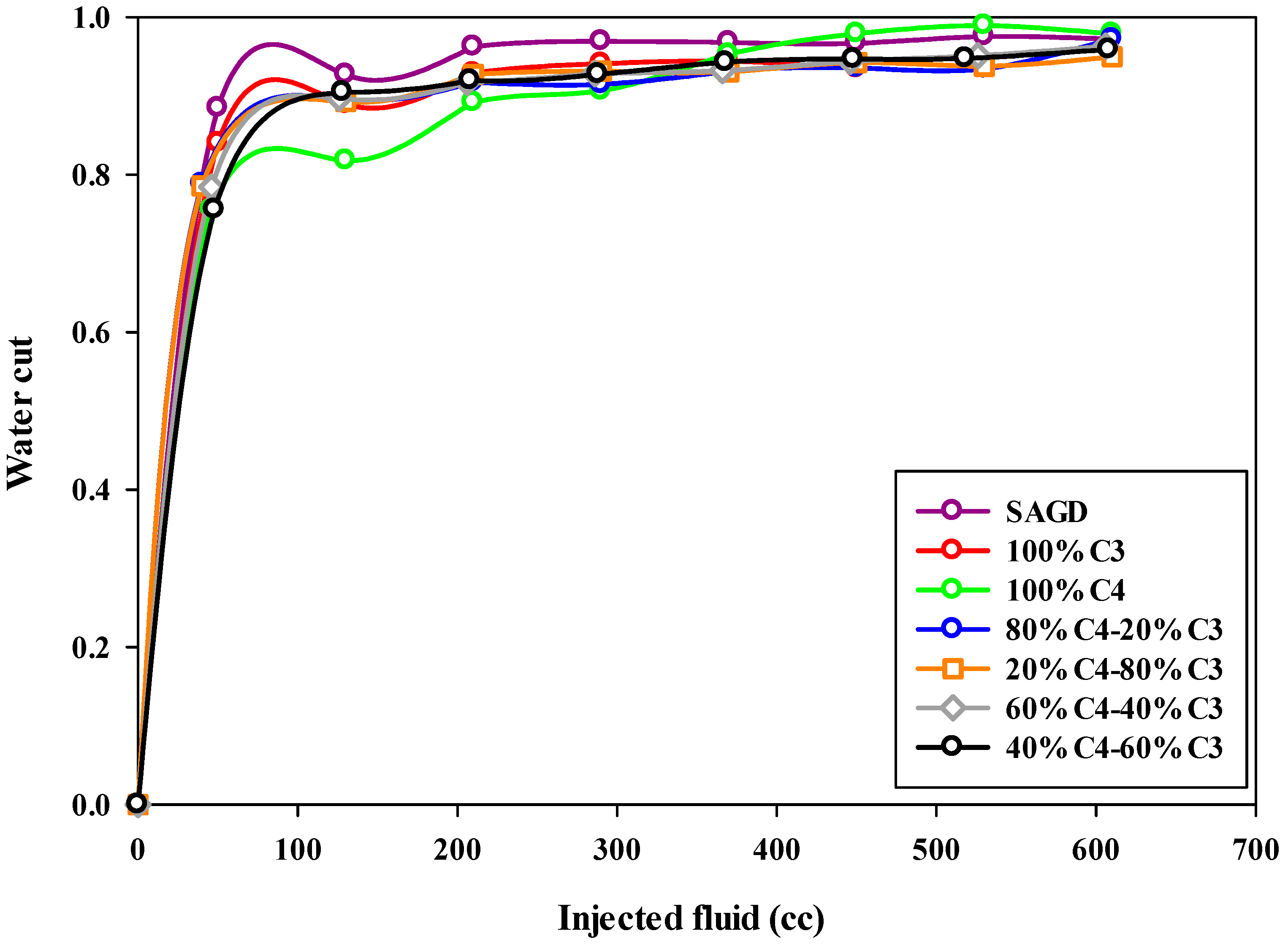
| Properties | Base-SAGD | ES-SAGD #1 | ES-SAGD #2 | ES-SAGD #3 | ES-SAGD #4 | ES-SAGD #5 | ES-SAGD #6 |
|---|---|---|---|---|---|---|---|
| Mass of sand (gr) | 278.5 | 283.6 | 278.6 | 285.3 | 284.1 | 279.6 | 281.3 |
| Volume of sand (cm3) 1 | 105.1 | 107.0 | 105.1 | 107.7 | 107.2 | 105.5 | 106.2 |
| Length of sand pack (cm) | 31.60 | 31.00 | 31.45 | 30.88 | 30.98 | 31.45 | 31.45 |
| Pore volume (cm3) | 54.92 | 55.00 | 55.30 | 56.20 | 56.20 | 55.00 | 56.9 |
| Porosity (%) | 36.40 | 35.79 | 36.37 | 36.60 | 36.18 | 36.32 | 37.16 |
| Permeability (mD) | 365.4 | 388.3 | 278.6 | 382.7 | 334.4 | 303.8 | 462.7 |
| Solvent composition | N/A | C3 | C4 | 80%C4 20% C3 | 20% C4 80% C3 | 60% C4 40% C3 | 40% C4 60% C3 |
| Steam flow rate (cm3/min) | 2.00 | 1.70 | 1.70 | 1.70 | 1.70 | 1.70 | 1.70 |
| Solvent flow rate (cm3/min) | 0.00 | 0.30 | 0.30 | 0.30 | 0.30 | 0.30 | 0.30 |
| Properties | Cum. Produced Water (gr) 1 | Swir (%) 2 | Cum. Produced Bitumen (gr) 1 | Sor (%) 2 | Final Recovery Factor (%) 2 | Final Water Cut (%) 3 | Cum. Injected Water (PV) |
|---|---|---|---|---|---|---|---|
| SAGD | 49.5 | 10.1 | 31.2 | 33.3 | 63.0 | 97.2 | 11.1 |
| ES-SAGD #1 | 51.1 | 7.3 | 40.4 | 19. 5 | 79.1 | 93.5 | 7.0 |
| ES-SAGD #2 | 52.2 | 5.8 | 48.5 | 6.7 | 92.9 | 97.9 | 9.4 |
| ES-SAGD #3 | 52.5 | 6.8 | 52.0 | 0.9 | 99.1 | 97.2 | 9.2 |
| ES-SAGD #4 | 51.2 | 9.1 | 48.7 | 4.5 | 95.1 | 94.7 | 9.2 |
| ES-SAGD #5 | 51.2 | 7.1 | 48.3 | 5.2 | 94.4 | 96.3 | 9.4 |
| ES-SAGD #6 | 51.8 | 9.2 | 45.9 | 10.5 | 88.5 | 95.9 | 9.1 |
Disclaimer/Publisher’s Note: The statements, opinions and data contained in all publications are solely those of the individual author(s) and contributor(s) and not of MDPI and/or the editor(s). MDPI and/or the editor(s) disclaim responsibility for any injury to people or property resulting from any ideas, methods, instructions or products referred to in the content. |
© 2025 by the authors. Licensee MDPI, Basel, Switzerland. This article is an open access article distributed under the terms and conditions of the Creative Commons Attribution (CC BY) license (https://creativecommons.org/licenses/by/4.0/).
Share and Cite
Esmaeili, S.; Maini, B.; Ul Abidin, Z.; Kantzas, A. Experimental Investigation of the Effect of Solvent Type and Its Concentration on the Performance of ES-SAGD. Methods Protoc. 2025, 8, 39. https://doi.org/10.3390/mps8020039
Esmaeili S, Maini B, Ul Abidin Z, Kantzas A. Experimental Investigation of the Effect of Solvent Type and Its Concentration on the Performance of ES-SAGD. Methods and Protocols. 2025; 8(2):39. https://doi.org/10.3390/mps8020039
Chicago/Turabian StyleEsmaeili, Sajjad, Brij Maini, Zain Ul Abidin, and Apostolos Kantzas. 2025. "Experimental Investigation of the Effect of Solvent Type and Its Concentration on the Performance of ES-SAGD" Methods and Protocols 8, no. 2: 39. https://doi.org/10.3390/mps8020039
APA StyleEsmaeili, S., Maini, B., Ul Abidin, Z., & Kantzas, A. (2025). Experimental Investigation of the Effect of Solvent Type and Its Concentration on the Performance of ES-SAGD. Methods and Protocols, 8(2), 39. https://doi.org/10.3390/mps8020039






